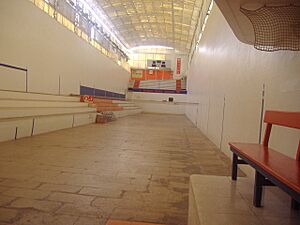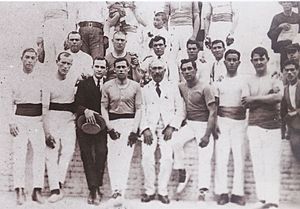Pelayo trinquet facts for kids
The Pelayo trinquet is one of the most famous courts for the sport of Valencian pilota in Valencia, Spain. It's a special place where important matches, like the finals of the Circuit Bancaixa, are played. Imagine a big, long court where players hit a ball with their hands – that's a trinquet!
History of Pelayo Trinquet
When Pelayo Trinquet Started
On August 20, 1868, a brand new trinquet court opened its doors. It was built right next to the Estació del Nord railway station on a street called Pelayo. That's how it got its name, the Pelayo trinquet!
A Long-Lasting Court
Since it first opened, the Pelayo trinquet has almost always been used for Valencian Pilota games. It has a long history of hosting exciting matches. For a short time during the Spanish Civil War, the court was managed by a different group.
Modern Updates to the Court
In 1976, the Tuzón family bought the trinquet. They worked hard to update and improve it, giving it the look it has today. Thanks to them, the Pelayo trinquet continues to be a top spot for the sport.
Exploring the Courtfield
How to Get to the Game
Today, the Pelayo trinquet is part of a restaurant and bar. To watch a game, spectators walk from the restaurant into a covered outdoor area. From there, they enter the trinquet court through a door near a special corner called the llotgeta.
Size and Features of the Court
The Pelayo trinquet is a very long court, perfect for Valencian Pilota. It is about 58.5 meters (192 feet) long, 11 meters (36 feet) wide, and 3 meters (10 feet) high. It's actually one of the widest trinquets around, which can be a fun challenge for players used to smaller courts. The court has bright lights and an electronic scoreboard to keep track of points.
Special Areas for Spectators and Officials
The Pelayo trinquet has four galleries, which are elevated areas for people to watch the game. There are two on the short end walls (called dau and rest) and two more along the side walls. The llotgeta is a wide, slightly raised area for watchers. It doesn't have a solid wall for protection, just a net to catch high balls. Above it, there's another special area for officials.
The Tricky Wooden Door
On the dau wall, near the llotgeta, there's a wooden door that leads to the outdoor patio. This door is often open, letting more people catch a glimpse of the game. Players sometimes aim the ball at this door to make it bounce in unexpected ways, making it harder for their opponents to hit back. When the door is closed, the ball can still bounce off the wood in surprising directions.
The "Tamborí" Bounces
At the bottom of the dau and rest walls, there's a sloped part called a "tamborí." It's angled at 45 degrees. When a low ball hits the tamborí, it bounces up quickly and unpredictably, adding more excitement to the game!
The Court's Ground and Roof
When the trinquet first opened, the ground was just gravel. Later, around the 1920s, it was covered with tiles. In 1976, a roof was added, making it an indoor court. Before the roof, balls sometimes flew out of the trinquet. Since the special vaqueta balls were expensive, someone (often a young boy) would have to go search for them. These ball-finders could even go into neighbors' yards and, in return, got free tickets to the matches!
Pelayo's Hall of Fame
Above the dau wall, there are five large pictures. These pictures show players who became true legends at the Pelayo trinquet and in the sport of Valencian Pilota. Since the court has been open for over 100 years and many players have competed there, having only five pictures shows how special and talented these chosen players were.
From left to right, these famous players are:
- José Vicente Riera Calatayud, known as El Nel de Murla
- Alberto Arnal, known as Quart
- Julio Palau Lozano, known as Juliet d'Alginet
- Antonio Reig, known as Rovellet
- Paco Cabanes Pastor, known as Genovés I
See also
 In Spanish: Trinquete de Pelayo para niños
In Spanish: Trinquete de Pelayo para niños



